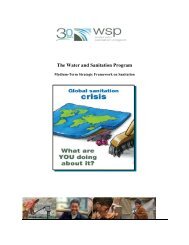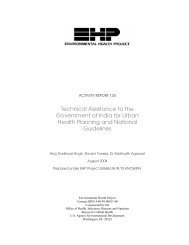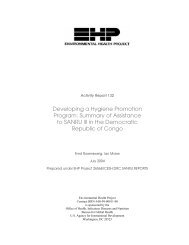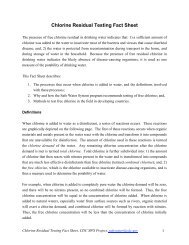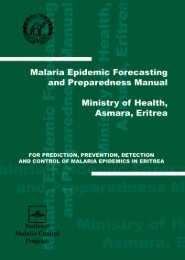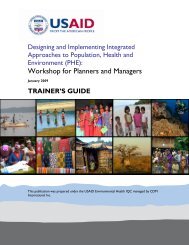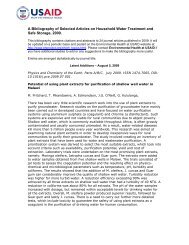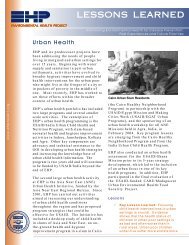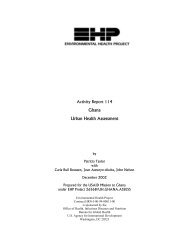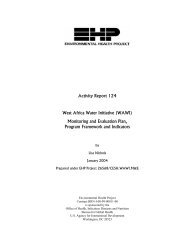Changing Glaciers and Hydrology in Asia - Environmental Health at ...
Changing Glaciers and Hydrology in Asia - Environmental Health at ...
Changing Glaciers and Hydrology in Asia - Environmental Health at ...
- No tags were found...
You also want an ePaper? Increase the reach of your titles
YUMPU automatically turns print PDFs into web optimized ePapers that Google loves.
SECTION 2GLACIERS AND HYDROLOGIC CHANGES/IMPACTSThe high mounta<strong>in</strong>s of <strong>Asia</strong> were a “white spot” <strong>in</strong> the Intergovernmental Panel on Clim<strong>at</strong>eChange’s (IPCC’s) 2007 Assessment Report—mean<strong>in</strong>g th<strong>at</strong> little to no d<strong>at</strong>a existed. Therefore,before develop<strong>in</strong>g programm<strong>at</strong>ic approaches for address<strong>in</strong>g possible impacts of glacier melt, asummary of exist<strong>in</strong>g scientific knowledge was required. This section describes the st<strong>at</strong>e ofknowledge about glacier melt <strong>in</strong> the heavily glaci<strong>at</strong>ed areas of the Himalayan region, <strong>in</strong>clud<strong>in</strong>g thevarious ways to measure glacier health, glacier dynamics, <strong>and</strong> current studies of the potentialimpacts of acceler<strong>at</strong>ed glacier melt.The ma<strong>in</strong> conclusion of this assessment is th<strong>at</strong> scientific studies <strong>and</strong> evidence are currently<strong>in</strong>adequ<strong>at</strong>e to assess how much melt is occurr<strong>in</strong>g across High <strong>Asia</strong> <strong>and</strong> wh<strong>at</strong> the r<strong>at</strong>es of changeare under various conditions. Different studies show the retre<strong>at</strong> of some glacier term<strong>in</strong>i, loss ofmass <strong>in</strong> some areas, <strong>and</strong> a few <strong>in</strong>dic<strong>at</strong>ions th<strong>at</strong> excess melt (th<strong>at</strong> is, more melt<strong>in</strong>g thanaccumul<strong>at</strong>ion) is not occurr<strong>in</strong>g <strong>in</strong> some areas. However, the d<strong>at</strong>a <strong>and</strong> studies <strong>in</strong> High <strong>Asia</strong> arenot extensive enough to provide a general assessment or projections of impacts. The lack ofd<strong>at</strong>a should not encourage complacency but presents a critical risk <strong>in</strong> effective prepar<strong>at</strong>ions foradapt<strong>at</strong>ion to clim<strong>at</strong>e change.2.1 BACKGROUNDGlacier retre<strong>at</strong> did not start with recent clim<strong>at</strong>e change, but with the more gradual clim<strong>at</strong>ewarm<strong>in</strong>g s<strong>in</strong>ce the Little Ice Age (LIA), which occurred from approxim<strong>at</strong>ely 1650 to 1850(Oerlemans 2005). Throughout the world, <strong>in</strong>clud<strong>in</strong>g the Himalaya, evidence left by glaciermora<strong>in</strong>es shows the maximum extent of these glaciers dur<strong>in</strong>g the LIA <strong>and</strong> quantifies the fact th<strong>at</strong>glaciers have been retre<strong>at</strong><strong>in</strong>g s<strong>in</strong>ce this period <strong>in</strong> response to a warmer clim<strong>at</strong>e.Wh<strong>at</strong> is new is the clear evidence of the acceler<strong>at</strong>ed pace of th<strong>at</strong> change <strong>in</strong> recent decades(Zemp et al. 2008). Many glaciers all over the world are retre<strong>at</strong><strong>in</strong>g—but differences exist, mostnotably because of different elev<strong>at</strong>ions. Glacier systems <strong>at</strong> the highest elev<strong>at</strong>ions, 4,000-7,000meters (m), have not responded to recent clim<strong>at</strong>e warm<strong>in</strong>g <strong>in</strong> the same way as glaciers th<strong>at</strong>extend to lower elev<strong>at</strong>ions, simply because glaciers <strong>at</strong> higher elev<strong>at</strong>ions rema<strong>in</strong> below freez<strong>in</strong>gdur<strong>in</strong>g much of the year, even <strong>in</strong> the presence of a warmer clim<strong>at</strong>e. Therefore, although glaciersare retre<strong>at</strong><strong>in</strong>g both <strong>in</strong> the European Alps <strong>and</strong> <strong>in</strong> the Himalaya, one cannot always make directcomparisons <strong>and</strong> extrapol<strong>at</strong>ions from the well-studied lower elev<strong>at</strong>ion glaciers to the morepoorly observed higher elev<strong>at</strong>ions of the Himalaya.2.2 MEASUREMENTS OF GLACIER TERMINUS FLUCTUATIONSPerhaps the simplest method to monitor mounta<strong>in</strong> glacier change is by record<strong>in</strong>g the annualloc<strong>at</strong>ion of the glacier term<strong>in</strong>us—the loc<strong>at</strong>ion <strong>at</strong> which the glacier extends furthest down valley.Abundant term<strong>in</strong>us histories are available from several regions of the world, Europe <strong>in</strong>particular. Compar<strong>at</strong>ive pictures show rapid retre<strong>at</strong> of some glaciers. But term<strong>in</strong>usmeasurements are mislead<strong>in</strong>g <strong>in</strong> the follow<strong>in</strong>g ways:13



